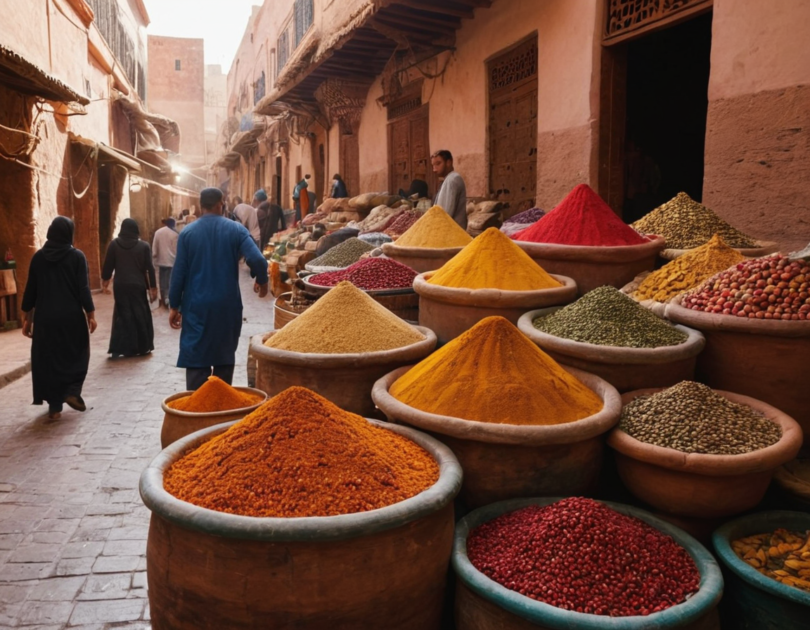Morocco, a country known for its rich cultural heritage, offers an unparalleled culinary experience that reflects its diverse history and geographic location. From the bustling souks of Marrakech to the peaceful coastal town of Essaouira, Moroccan cuisine is a fusion of Berber, Arab, and European influences, with each region boasting its own distinct flavors and traditional dishes. For food lovers and cultural enthusiasts alike, embarking on a culinary cultural tour through Morocco promises to be a journey of indulgence, discovery, and appreciation.
The Essence of Moroccan Cuisine: A Fusion of Flavors
Moroccan cuisine is a sensory experience that blends diverse flavors, textures, and colors. Spices, herbs, and fresh ingredients are integral to every dish, creating a flavor profile that is both bold and complex. Some of the most iconic ingredients in Moroccan cooking include cumin, coriander, saffron, ginger, paprika, and cinnamon. These spices, often combined with preserved lemons, olives, and dates, infuse dishes with layers of aromatic depth.
The Role of Spices in Moroccan Cooking
Spices are not only used for flavor but also for medicinal purposes, as many have healing properties. Ras El Hanout, a spice mix that can contain up to 30 different spices, is commonly used in tagines and stews, providing a distinct and unforgettable taste. The balance of sweet and savory is a hallmark of Moroccan dishes, with combinations like chicken with preserved lemons and olives or lamb with prunes and almonds showcasing the art of blending contrasting flavors.
Signature Dishes of Morocco: A Taste of Tradition
Tagine: A Slow-Cooked Delight
Arguably the most iconic Moroccan dish, tagine is a slow-cooked stew that features a variety of meats, vegetables, and aromatic spices. Named after the unique clay pot in which it is prepared, tagine is a perfect example of the country’s commitment to slow cooking and bold flavors. Whether made with lamb, chicken, or fish, the cooking method ensures that the ingredients are infused with the spices and come out tender and flavorful. The addition of fruits such as apricots, prunes, and dates adds a sweet contrast to the savory elements of the dish, elevating the overall flavor profile.
Couscous: A Staple of Moroccan Cuisine
No culinary tour of Morocco would be complete without tasting couscous, the staple food of the country. Traditionally served on Fridays as a communal dish, couscous is made from steamed semolina wheat and is typically served with a stew of meat and vegetables. The fluffy texture of the couscous, combined with the richness of the stew, creates a satisfying and comforting meal. It is often garnished with raisins, almonds, and a variety of spices to enhance its flavor.
Pastilla: A Sweet and Savory Pie
Pastilla, a savory pie made from layers of thin pastry dough, is another beloved Moroccan dish. Typically filled with pigeon or chicken, almonds, and eggs, the filling is spiced with cinnamon and saffron, giving it a unique blend of flavors. The pie is then baked and dusted with powdered sugar, creating an unexpected sweetness that contrasts with the savory filling. Pastilla is often served as a special dish during festive occasions, showcasing the culinary ingenuity of Moroccan chefs.
Regional Delights: Exploring the Flavors of Morocco’s Diverse Regions
While Moroccan cuisine is united by its use of spices and slow-cooked dishes, each region offers its own take on traditional flavors, influenced by geography, climate, and culture.
Marrakech: A Bustling Hub of Flavor
Marrakech, one of Morocco’s most famous cities, is a melting pot of flavors, scents, and sounds. The city is home to vibrant souks where vendors sell fresh produce, aromatic spices, and street food. In the evening, the Jemaa el-Fnaa square comes alive with food stalls serving everything from grilled meats to snails in broth, allowing visitors to immerse themselves in the city’s culinary culture.
One of the must-try dishes in Marrakech is kefta, which consists of spiced minced meat skewers, typically grilled over charcoal. Harira, a rich soup made with tomatoes, lentils, chickpeas, and lamb, is another popular dish enjoyed during Ramadan and other festive occasions. It is typically served with dates and sfenj, a type of Moroccan doughnut, to complement the rich flavors.
Fez: A City of Culinary Traditions
Fez, often considered the culinary capital of Morocco, is renowned for its traditional dishes and long-standing food culture. The city’s food is deeply rooted in history, and many dishes here are passed down through generations. Mechoui, a slow-roasted lamb dish, is one of the city’s specialties, often served in large gatherings and celebrations.
B’stilla is another dish that traces its origins to Fez. This sweet and savory pie, filled with pigeon, eggs, and almonds, is spiced with saffron and cinnamon and embodies the city’s ability to blend flavors in unexpected ways.
Coastal Cuisine: Seafood in Essaouira and Beyond
The coastal towns of Morocco offer a unique opportunity to indulge in the freshest seafood. Essaouira, a UNESCO World Heritage Site, is known for its vibrant fishing port and seafood restaurants. Grilled fish, including sardines, squid, and octopus, is a specialty in the region. The simple yet flavorful dishes highlight the freshness of the catch, often accompanied by chermoula, a marinade made from herbs, garlic, and spices.
In addition to seafood, harira soup is commonly enjoyed along the coast, especially during the cooler months. The soup, which includes tomatoes, lentils, chickpeas, and meat, is rich in flavor and provides warmth and comfort.
Moroccan Sweets and Desserts: A Sweet Finale
No Moroccan culinary tour would be complete without indulging in the country’s incredible range of desserts. Baklava, a sweet pastry made from layers of filo dough, honey, and nuts, is a popular treat. Makroud, a semolina-based cake filled with dates and nuts, is another traditional dessert, often served during religious celebrations.
One of the most iconic Moroccan sweets is chebakia, a deep-fried dough pastry coated in honey and sesame seeds. Typically enjoyed during Ramadan, this indulgent treat is the perfect way to conclude a Moroccan meal.
Mint Tea: A Symbol of Hospitality
No discussion of Moroccan cuisine would be complete without mentioning mint tea. Often referred to as “Moroccan whiskey,” mint tea is a symbol of hospitality and is served in almost every home and restaurant. The sweet, refreshing tea is made by brewing green tea with fresh mint leaves and sugar, creating a fragrant and flavorful beverage that is enjoyed throughout the day.
Conclusion: A Journey of Flavors and Culture
Embarking on a culinary tour through Morocco is more than just a chance to savor its delicious dishes; it’s an opportunity to immerse oneself in the country’s rich cultural heritage. From the vibrant spices and ingredients to the traditional cooking techniques, Moroccan cuisine offers a unique blend of flavors that reflect the diverse history and geography of the country. Whether you’re enjoying a slow-cooked tagine in Marrakech or indulging in fresh seafood in Essaouira, Morocco’s food scene promises an unforgettable experience for all who are lucky enough to explore it.







